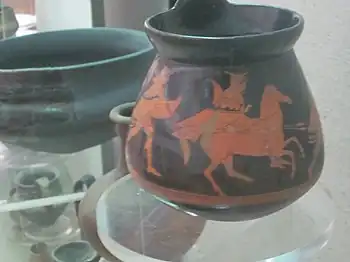Treri
Treri (Ancient Greek: Τρηροι, romanized: Trēroi, or Τρηρες, romanized: Trēres; Latin: Treri or Treres) is the name of a Thracian tribe.
In Thrace
The Treri lived in northwest Thrace, in the region of Serdica (now the Bulgarian capital city of Sofia). The Treri of the Serdica region were later absorbed by the Triballi during this latter tribe's eastward migration and disappeared from history afterwards.[1]

In Anatolia
At some point in the 7th century BCE, a portion of the Treres migrated across the Thracian Bosporus and invaded Anatolia.[2] By the later part of the 7th century BCE, these Treres were nomadising in Western Asia along with the Cimmerians.[3]
In 637 BCE, the Treres, under their king Kōbos (Ancient Greek: Κωβος; Latin: Cobus) and in alliance with the Cimmerians and the Lycians, attacked the Anatolian kingdom of Lydia during the seventh year of the reign of the Lydian king Ardys.[4] They defeated the Lydians and captured their capital of Sardis except for its citadel, and Ardys might have been killed in this attack.[5] Ardys's son and successor, Sadyattes, might possibly also have been killed in another Cimmerian attack on Lydia in 635 BCE.[5]

Soon after 635 BCE, with the approval of the Neo-Assyrian Empire, which was an ally of Lydia as well as the then superpower in Western Asia,[6] and in alliance with the Lydians,[7] the Scythians under their king Madyes entered Anatolia, expelled the Treres from Asia Minor, and defeated the Cimmerians so that they no longer constituted a threat again, following which the Scythians extended their domination to Central Anatolia[8] until they were themselves expelled by the Medes from Western Asia in the 600s BCE.[4] This final defeat of the Cimmerians was carried out by the joint forces of Madyes, whom Strabo credits with expelling the Treres and Cimmerians from Asia Minor, and of Sadyattes’s son and Ardys’s grandson, the Lydian king Alyattes, whom Herodotus of Halicarnassus and Polyaenus claim finally defeated the Cimmerians.[9][10]
References
- Mihailov, G. (1991). "Thrace Before the Persian Entry into Europe". In Boardman, John; Edwards, I. E. S.; Hammond, N. G. L.; Sollberger, E.; Walker, C. B. F. (eds.). The Cambridge Ancient History. Vol. 3. Cambridge: Cambridge University Press. pp. 591–618. ISBN 978-1-139-05429-4.
- Diakonoff 1985, p. 94-95.
- Olbrycht, Marek Jan (2000). "The Cimmerian Problem Re-Examined: the Evidence of the Classical Sources". In Pstrusińska, Jadwiga [in Polish]; Fear, Andrew (eds.). Collectanea Celto-Asiatica Cracoviensia. Kraków: Księgarnia Akademicka. ISBN 978-8-371-88337-8.
- Spalinger, Anthony J. (1978). "The Date of the Death of Gyges and Its Historical Implications". Journal of the American Oriental Society. 98 (4): 400–409. doi:10.2307/599752. JSTOR 599752. Retrieved 25 October 2021.
- Dale, Alexander (2015). "WALWET and KUKALIM: Lydian coin legends, dynastic succession, and the chronology of Mermnad kings". Kadmos. 54: 151–166. doi:10.1515/kadmos-2015-0008. S2CID 165043567. Retrieved 10 November 2021.
- Grousset, René (1970). The Empire of the Steppes. Rutgers University Press. p. 9. ISBN 0-8135-1304-9.
A Scythian army, acting in conformity with Assyrian policy, entered Pontis to crush the last of the Cimmerians.
- Diakonoff 1985, p. 126.
- Phillips, E. D. (1972). "The Scythian Domination in Western Asia: Its Record in History, Scripture and Archaeology". World Archaeology. 4 (2): 129–138. doi:10.1080/00438243.1972.9979527. JSTOR 123971. Retrieved 5 November 2021.
- Ivantchik 1993, p. 95-125.
- Ivantchik 2006, p. 151.
Sources
- Diakonoff, I. M. (1985). "Media". In Gershevitch, Ilya (ed.). The Cambridge History of Iran. Vol. 2. Cambridge: Cambridge University Press. pp. 94–95. ISBN 978-0-521-20091-2.
- Ivantchik, Askold (1993). Les Cimmériens au Proche-Orient [The Cimmerians in the Near East] (PDF) (in French). Fribourg, Switzerland; Göttingen, Germany: Editions Universitaires (Switzerland); Vandenhoeck & Ruprecht (Germany). ISBN 978-3-727-80876-0.
- Ivantchik, Askold (2006). Aruz, Joan; Farkas, Ann; Fino, Elisabetta Valtz (eds.). The Golden Deer of Eurasia: Perspectives on the Steppe Nomads of the Ancient World. New Haven, Connecticut, United States; New York City, United States; London, United Kingdom: The Metropolitan Museum of Art; Yale University Press. p. 146-153. ISBN 978-1-588-39205-3.